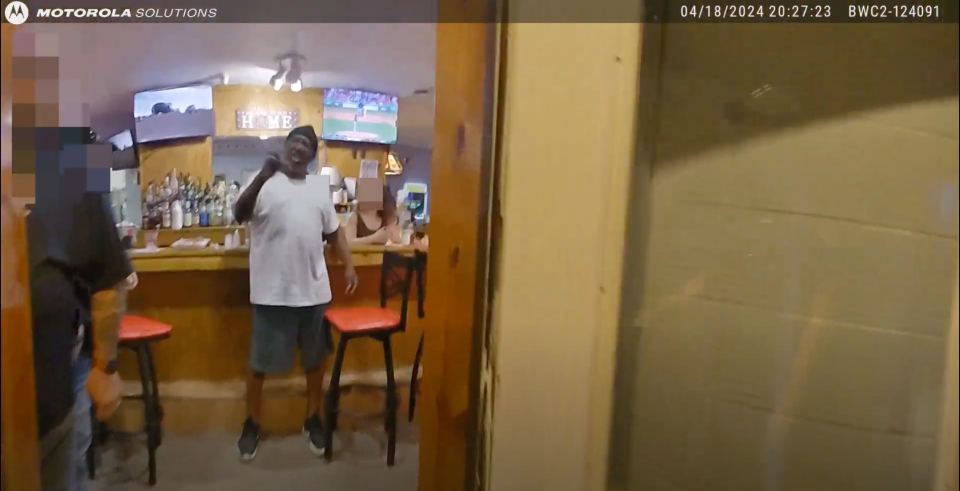Death of Frank Tyson, Ohio man who told police 'I can't breathe' has echoes of George Floyd
- Oops!Something went wrong.Please try again later.
CANTON, Ohio ‒ Newly released body camera footage shows the arrest of an Ohio man who died during a confrontation with police, which an attorney representing his family said resembled the 2020 murder of George Floyd in Minneapolis.
Frank Tyson, 53, died April 18 during an encounter with police after he crashed his car and entered a nearby private club. Both Tyson and Floyd said, "I can't breathe," before their deaths.
“The death of George Floyd traumatized and galvanized the American people – it led to a decisive call for change and an end to systemic police violence against Black men," Bobby DiCello, an attorney for the Tyson family, said in a statement released Friday.
"It’s an unimaginable tragedy, that only four years later history repeats itself. Why tackle him? Why kneel on him? How could you know he lost consciousness and then do nothing? These questions demand answers. And so, we will get those answers for Frank and the whole Tyson family in this time of pain, grief, and disbelief," DiCello said.
George Floyd is not alone: 'I can’t breathe' uttered by dozens in fatal police holds across U.S.
What happened to Frank Tyson?
Authorities said Tyson crashed his car, then entered a private club and was acting erratically. Two police officers tried to remove Tyson from the club and took him to the floor during an ensuing scuffle. Tyson, who told people at the club that someone was trying to kill him before officers arrived, yelled, "They're trying to kill me," as officers fought with him.
Police body camera footage released Wednesday by the city shows Tyson facedown on the floor with his arms handcuffed behind his back for nearly eight minutes before an officer realized he couldn't feel a pulse. Officers took the handcuffs off and applied chest compressions for several minutes.
Tyson was subsequently treated by Canton Fire Department paramedics, who took him to a local hospital where he was pronounced dead.
Canton police have turned the investigation of Tyson's death over to the Ohio Bureau of Criminal Investigation. Officers Beau Schoenegge and Camden Burch have been placed on administrative leave.
The Stark County Coroner's Office sent Tyson's body to the Cuyahoga County Medical Examiner's Office for an autopsy. The cause of death has not been released. The Stark County chapter of the NAACP on Friday posted a message on Facebook, saying the civil rights organization is monitoring the situation.
"Our thoughts and prayers are with the family," the group said.
Expert questions Canton police response used on Frank Tyson

Kalfani N. Ture, a former police officer and assistant professor of criminal justice and African American studies at Widener University in Chester, Pennsylvania, said officers should not have left Tyson facedown on the floor for so long after they handcuffed his arms behind his back. Ture said that creates the potential for Tyson to suffocate due to the position of his body, a condition known as positional asphyxiation.
“It takes less than six minutes for a life to expire in the context of a positional asphyxiation situation," Ture said.
Ture, who trains New York City police officers, said the responding officers were also indifferent to Tyson's condition, with one telling him to "calm down." He said the gurgling noises Tyson made while lying on his stomach sounded similar to those made by Floyd.
“Well, you have this gentleman in restraints. He is not kicking. He's trying to lift up ... just to breathe," Ture said.
What is positional asphyxiation?
The U.S. Department of Justice advised law enforcement about positional asphyxia in a June 1995 fact sheet. The federal agency advised officers to "remove the subject from their stomach as soon as they are handcuffed" and monitor them carefully, according to the advisory from the National Institute of Justice, the research, development, and evaluation agency of the U.S. Department of Justice.
Ture, a former city, state and county law enforcement officer, said police are also trained to prevent positional asphyxiation.
“We learned in the police academy, and this is universal," he said. "We all learned about positional asphyxiation. The chest cannot expand against a hard, flat structure. Our stomach and our thoracic cavity expands forward, and if you are in a prone position against a hard structure, you're going to suffocate. You're going to asphyxiate. We are trained that once you secure the person in handcuffs, you immediately sit them up in a resting position."
Since 2000, more than 340 people have died in police custody due to "asphyxia/restraint," according to the Fatal Encounters database. A USA TODAY investigation found dozens said "I can't breathe" during the fatal restraints.
Contributing: N'dea Yancey-Bragg, USA TODAY
Follow Nancy on X, formerly Twitter: @nmolnarTR.
This article originally appeared on The Repository: In video, Frank Tyson tells Ohio police 'I can't breathe' before death

